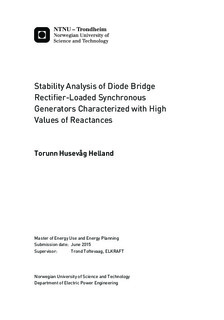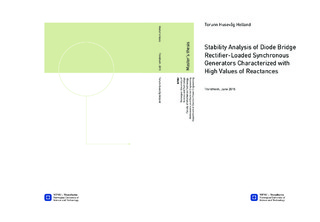| dc.description.abstract | This thesis concerns the stability of diode bridge rectifier-loaded synchronous generators characterized by large values of synchronous, transient and subtransient reactances in the d- and q-axis, with the possibility of connecting a battery-bank. The synchronous reactances are in the range 2.5-5.5pu.
The electrical system studied is installed in two tug-ships using two different types of generators, with different ranges of generator reactances and performance. One of the tugships studied uses generators with a capacity of 3333kVA, has synchronous reactances is the lower layer of 2.5-5.5 pu and is characterized as stable during operation. The other ship uses generators with a capacity of 1940kVA, has synchronous reactances is the upper layer of 2.5-5.5 pu and is characterized as unstable during operation. The observed oscillations in this ship have a frequency of approximately 2Hz.
The diesel-electric, variable speed propulsion DC-system used on the two ships is delivered by Siemens. The synchronous generators deliver power to a dc-bus through six-pulse diode bridge rectifiers. The main motors and thrusters are supplied by the dc-bus through inverters, and a battery can be attached to the dc-bus for redundancy. The object of this thesis is to find the reason why rectifier-loaded synchronous generators with high reactances become unstable.
The same system was under study for a specialization project conducted at the Department of Electrical Power Engineering during the fall of 2014. The main findings in this project are included in the present thesis, where simulations indicate that the studied generators become unstable when the gain of the voltage regulator is increased, and no rectifier is included in the model. This happens faster for the 1940kVA generator than for the 3333kVA generator, and when reactive power is consumed.
A literature study of articles and other work concerning the stability of similar systems is also conducted. It is in literature found that local mode problems often is associated with rotor angle oscillations, and usually has a frequency of 0.7-2Hz. Stability criteria is found concerning diode bridge rectifier-loaded synchronous
The stability criteria found have requirements for the synchronous and transient reactance, but not for the subtransient reactance. It is claimed that small-frequency oscillations starts in the rectifier causing instability of rectifier-loaded synchronous generators. It is also found a criterion saying that stability is easier achieved by adding a short-circuited q-axis winding on the rotor.
The work of the specialization project is continued, and a rectifier is added to the model established in DIgSILENT PowerFactory in the fall of 2014. The battery is modeled as a constant DC-voltage source, and the rectifier is modeled as a PWM rectifier with no modulation and a firing angle set to zero. The generator stability is studied when the gain of the voltage regulator is increased from 50-500. The simulation is made for both producing and consuming reactive power, both cases of which the generator produces active power.
The gain directly affects the nature of the linearization constant K5 making it negative resulting in a negative feedback when the external impedances is high. The hypothesis is that this also happens when the internal reactances in the generator is high. This is shown through simulations to be true. It was expected that the 1940kVA generator reaches instability faster than the 3333kVA generator, as was the result in the specialization project, but this was not the case. It is believed that the rectifier chosen does not imitate the real system well enough.
By using the parameters of the 3333kVA and 1940kVA generators, as well as knowledge of the ship components, simplified models are established in the simulation tool MatLab/SimPowerSystems.
The battery in MatLab/SimPowerSystems is modeled as an infinitely large capacitor and a series resistance, and the rectifier is a diode-bridge rectifier. A sensitivity analysis for parameter values is conducted, by varying parameter values of the main components such as the synchronous generator, battery, rectifier and voltage regulator, and the stability is studied. The impact of the presence of the main components on the stability is studied as well. Neither of the criteria found in \cite{Teil1} and \cite{siemens} has requirements for the subtransient reactance, and the impact of the subtransient reactance on the stability is studied through sensitivity analysis. Different load-situations are simulated and generator stability is examined.
The main phenomena observed on the ship are successfully recreated through simulations, and the model established in the simulation tool is verified due to this. It is through simulations found that the presence of the diode-bridge rectifier is crucial to detect stability problems, and that the load-situation impacts the stability. When the 1940kVA generator supplies a load of 1.9MVA, it becomes stable, but is unstable during no-load and for all other loads less than 1.9MVA.
It is also found that the transient and subtransient reactances play an equally important role as the synchronous reactances when it comes to generator stability in this context. The sensitivity analysis conducted is used as a basis for the development of stability limits. The results found through simulations are compared with stability criterions and theories presented in articles found in the literature study concerning the same problems as addressed in this thesis.
Stability criteria are found for the 1940kVA generator with emphasis on the transient and subtransient reactance. By combining the stability criterion for the transient reactances obtained in this thesis with equations found in literature, it is found that stability can be achieved by adding a short-circuited q-axis winding to the generator rotor.
Recommendations for further work is to replace the PWM rectifier with a diode-bridge rectifier in the DIgSILENT PowerFactory model and redo the varying of the gain in the voltage regulator to study the stability of the 3333kVA and 1940kVA generators. It is also suggested that the interaction between the synchronous generator and diode-bridge rectifier is further investigated. Last, but not least should simulation be conducted, where a short-circuited q-axis winding is added to the generator rotor, to verify the results found in this thesis from the stability criteria obtained. | |

